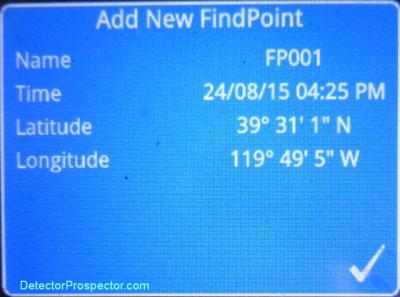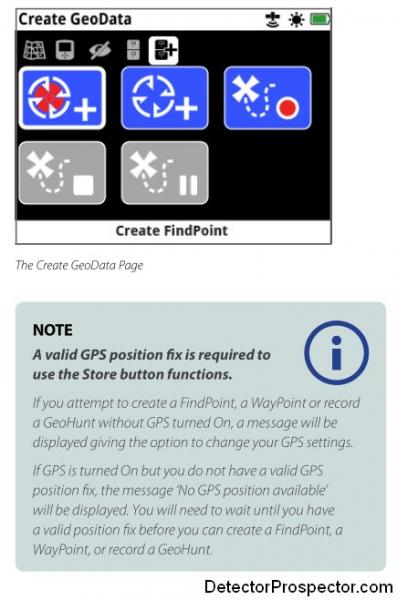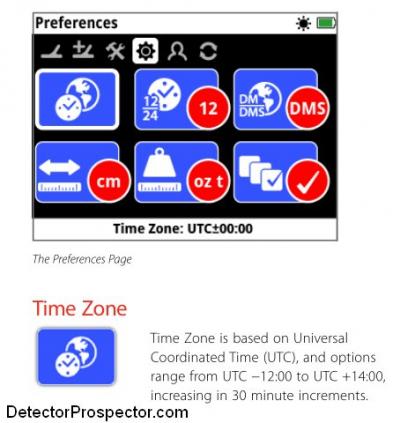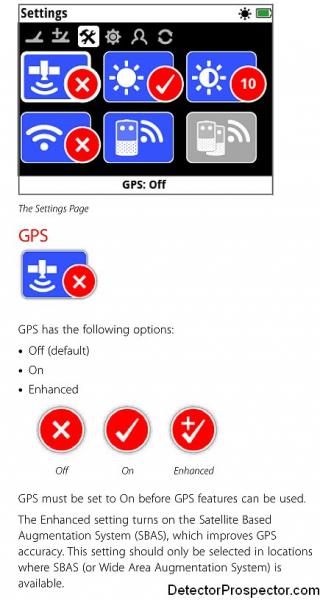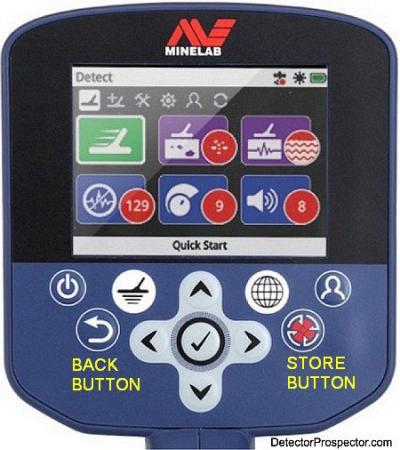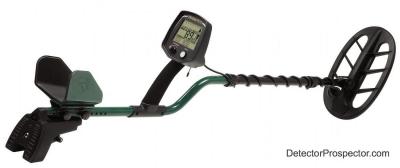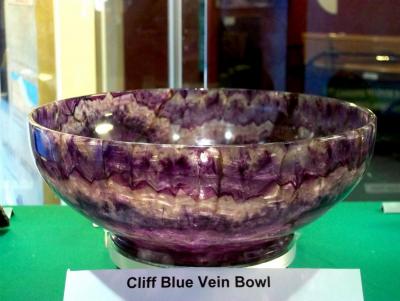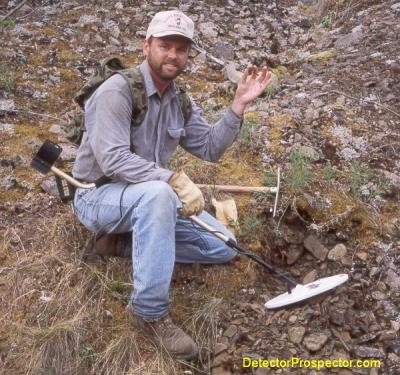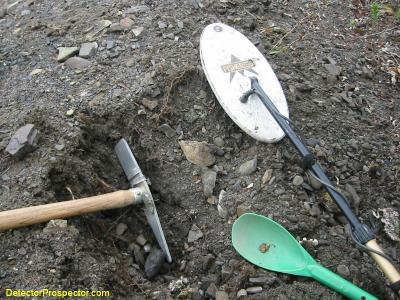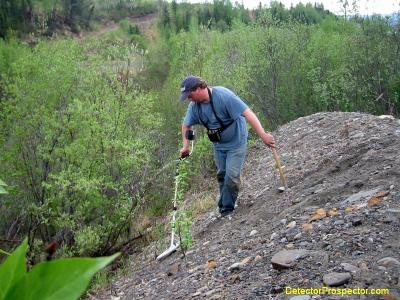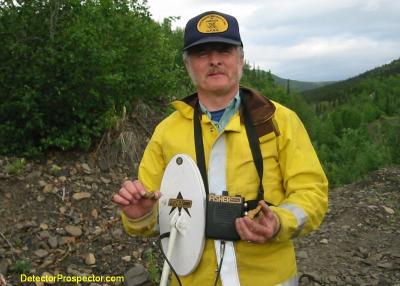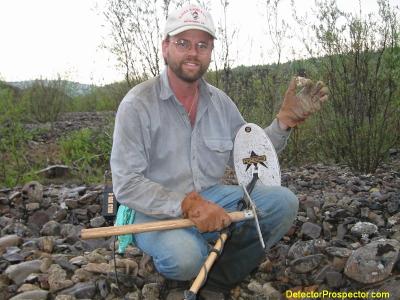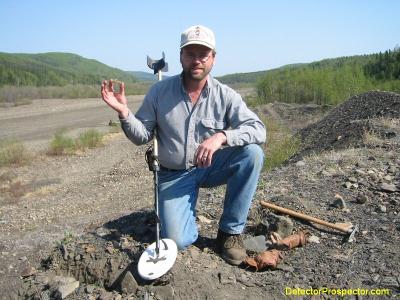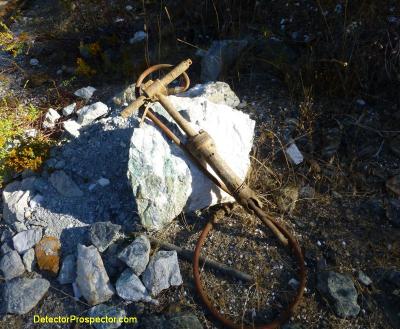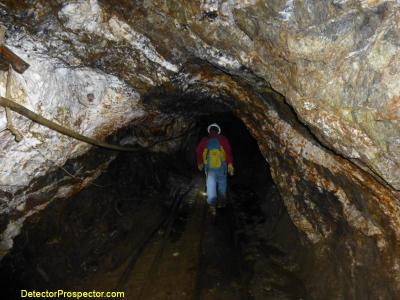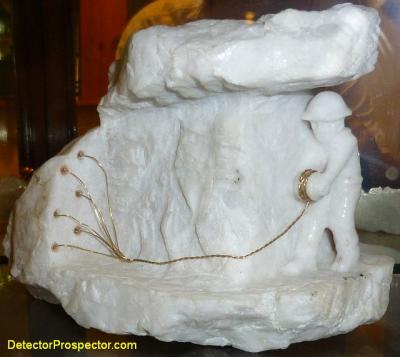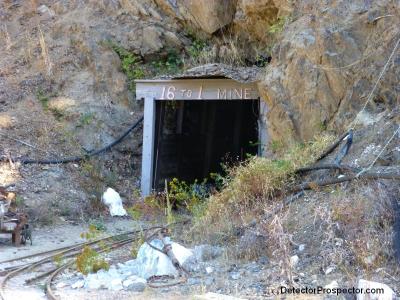-
Posts
19,751 -
Joined
Content Type
Forums
Detector Prospector Home
Detector Database
Downloads
Everything posted by Steve Herschbach
-
The Minelab CTX 3030 has a clock on screen, and so I have puzzled over why it was removed from the GPZ 7000. I finally noticed the other day that the GPZ 7000 does have a built in clock but it is hidden. To get the time the GPS must be turned on, and it is off by default. Go to the Settings screen and activate the GPS. You also need to set the proper time zone in the Preferences/Time Zone screen. This does not adjust for daylight savings time so set accordingly. The easiest thing is just take your best guess then double check the time once you get this running and adjust if need be. OK, once you have a satellite fix you are good to go. I am always tracking myself anyway so my GPS is always on. Once set for on it stays on by default when you power the detector up unless you go back and shut it down. Now, push the red Store Button on the lower right control panel. This will bring up the Create Geostore page, and the Create Findpoint menu item will be highlighted by default. Select the Create Findpoint menu item and you will see this screen, and there is your current time! Normally at this point you would create a Findpoint by pushing the selection button again and adding the target (nugget) depth and weight. Instead, once you see the time, just push the Back Button on the lower left control panel, and get back to detecting. A Findpoint will not be created. In practice you push the Store button, then push the Enter (Checkmark) button, see the time, and then push the Back button. Done!
-
I am in full agreement Hard Prospector. There was a time when each leap in technology really did make a difference, but all along the resource has been depleting. For various reasons adding a couple more inches just is not going to do it anymore. As you note, the SDC and GPZ are specifically designed to go after gold missed by the previous Minelab models but basically all it is are leftovers. The constantly increasing gold price also masked depleting returns by making it possible to get as much cash for lower weight returns. But now with less gold and lower prices it is starting to catch up. The guys to get hit first will be those who truly are in it to make a buck. I like to say I do it because I love it but I could also be looking for quartz crystals or other fun to find stuff. Fun is fun but the fact that gold does have value does make a difference. Even those not really finding anything like to think maybe, just maybe one big nugget could really make a serious payday happen. As chances for a monetary return become low to nothing there will be fewer and fewer people sticking with the detecting for gold gig.
-

The 7000 Ferrite - Something Different
Steve Herschbach replied to Bada Bing's topic in Minelab Metal Detectors
I got a nice note from Minelab this morning explaining that taping the ferrite ring to the coil is not a good idea. "This is not recommended and will degrade detector performance. 1. The ZVT signal processing needs to combine the ferrite signal with the ground signal only for a short period of time during the ground balancing process, not as tracking continues in the background after the Quick-Trak operation is completed 2. Taping the ferrite to the coil will cause the ferrite signal not to be properly sensed because it will be moving in conjunction with the coil. The coil needs to move across the ferrite with the ferrite stationary for best results." -

Why Can't I Get Spare Batteries For My GPZ 7000?
Steve Herschbach replied to nvchris's topic in Minelab Metal Detectors
Running time is far longer on the WM12, like over double. Besides, you can always use wired headphones. I have a couple spare CTX batteries I carry for backup but 99% of the time the main battery gets me through the day and gets charged that night. Could be a problem off grid but that is rarely an issue for me. The higher capacity GPZ battery is physically larger and heavier, and may make the GPZ balance better for those that like running the coil all the way out. -

Found A Virgin Patch
Steve Herschbach replied to Sourdough Scott's topic in Detector Prospector Forum
Just goes to show there is usually more to be found with extra effort - good job Scott! -
I think that with lower gold prices fewer new people are getting into nugget detecting. The old timers know what they are doing - they are just out prospecting. The only thing that stirs up discussion is the release of a new detector, and that runs out of steam after a few months. Like most I am pretty darn busy during the summer and so my online activity tends to pick up in the winter when I have more time to devote to it.
-

Got The Nokta Fors CoRe Yesterday....
Steve Herschbach replied to bado1's topic in Nokta / Makro Metal Detectors
Great advice! If you are really new to detecting taking it easy with sensitivity is a wise thing also. Get used to the machine in easy mode where it falses less often and gets those solid target id numbers. Turning the sensitivity up does boost performance but the machines get "sparkier". The FORS run hotter than most even at lower sensitivity levels. Push for the most sensitivity that allows you to get tolerably stable operation. The ID Mask is preset at 10 to help eliminate most ground noise and many hot rocks. In milder ground lowering it does just as californiagold says. It is just a discrimination control that runs well into the ground response range. Steve tip - digging a few hot rocks never hurt anyone, and gold does phase all the way into reading like hot rocks under certain conditions. -
Thanks Norm for the chance to handle the gold and take the photos. That sure had a nice hefty feel in my hand!
-

Got The Nokta Fors CoRe Yesterday....
Steve Herschbach replied to bado1's topic in Nokta / Makro Metal Detectors
I do like my PI detecting and try to be a dig everything guy, but in a place where no gold has been found yet and there is a ton of trash a good VLF makes more sense. Now, if you do find a nugget, put the PI on the immediate area and dig everything. The FORS is a great machine for this. -

Why Can't I Get Spare Batteries For My GPZ 7000?
Steve Herschbach replied to nvchris's topic in Minelab Metal Detectors
From http://www.fortbedfordmetaldetectors.com/minelab-CTX-GPZ-battery Minelab CTX and GPZ battery options: 3011-0118 Stock CTX 3030 4.4 Ah battery $149 3011-0279 Stock GPZ 7000 10.0 Ah battery $195 3011-0280 Upgraded 13.3 Ah battery $234 This is the first mention I have seen of a talked about optional larger capacity battery for the GPZ. The page says in stock - but are they? -

TDI Moore Creek Setting?
Steve Herschbach replied to auminesweeper's topic in White's Metal Detectors
My original TDI was as noisy as any of them, and I owned several at Moore Creek. Just like the SDC 2300 is inherently noisy. All that means is a ratty threshold as opposed to a smooth threshold. Some people it just drives nuts, to me it is just the way some detectors run. My ear rapidly normalizes whatever threshold sound a detector makes and picks out something abnormal as being a signal to be dug. https://www.detectorprospector.com/magazine/steves-mining-journal/whites-tdi-moore-creek-alaska/ The only thing I tend to do different with noisy detectors (GPZ is another) is turn down the volume or other audio settings to make the ratty threshold minimally distinct while still allowing actual targets to stand out. I can see how if a person listened to that stuff set too loud all day it would be wearing. I barely hear it. -
Interesting that they decided to undercut even their own new detectors like the Omega 8500. The T2 packs a lot of raw power for $499 and I would certainly choose it over the 8500. And what about the F75 at $949? Are we going to see a reduced price "F75 Classic"? A direct shot at the Nokta FORS and Makro Racer perhaps? Those machines share a lot of the T2 characteristics, so much so you would think those machines were based on the T2. At this price the T2 is a better buy with the FORS Gold and FORS CoRe at $595. I see they are finally trying to get rid of the 15" coils for what they are really worth. Way too heavy for the machines they are designed for. When old top range detectors get moved to the mid range it makes me wonder what's next at the top. All I can say is this resets what a person should expect for $500 in the way of a detector. Very aggressive on First Texas part. You can download the owners manual for the T2 Classic here. The green is much nicer in real life than the over saturated ad implies. Teknetics T2 Classic
-

Got The Nokta Fors CoRe Yesterday....
Steve Herschbach replied to bado1's topic in Nokta / Makro Metal Detectors
I kept the CoRe for this very reason. I figure it is better able to handle salt ground common in Nevada http://www.detectorprospector.com/forum/topic/531-difference-between-nokta-fors-gold-and-fors-core/ -
You ever hear people yell underwater? Check out this video of another new find in Florida worth over $4 million https://youtu.be/lpJ9SgF2nW4 Story http://www.usatoday.com/story/news/nation-now/2015/08/19/florida-divers-350-gold-coins/31982885/ and http://mashable.com/2015/08/19/florida-shipwreck-gold/
-

Tailing Pile Mineralization?
Steve Herschbach replied to auminesweeper's topic in Detector Prospector Forum
Stripping piles are comprised of overburden and share the exact same composition as the overburden except it has been moved around. This could change the alignment of the magnetic particles from undisturbed ground resulting in some variation in ground balance. Sometimes lots of organics get mixed in and this can also change things. Once washed the silt, clays and heavies are usually gone, and that can make the resulting tailing pile easier to deal with. And cobble piles as I have noted are further sorted. The end result is tailing piles can differ somewhat from the surrounding ground mineralization but still derive their overall nature from the ground that produced the tailings. Cobble piles made up of larger rocks can also be very problematic for VLF detectors. Sometimes you get a pile where all the cobbles are quite different rocks. There really is not much to ground balance to as all the rocks are different. Balance to one, the next rock is different. The best you can shoot for is a kind of average. Ground tracking can be very helpful on these sorts of piles as it tends to take the edge off the rock responses. Higher frequency VLFs are not as smooth as lower frequency VLF detectors on these types of cobble piles, and a PI generally eliminates the issue. As always, tailing piles tend to differ also from having high trash content and trash to great depth as compared to virgin ground. -

Tailing Pile Mineralization?
Steve Herschbach replied to auminesweeper's topic in Detector Prospector Forum
Tailing piles are not necessarily lower mineralization than other areas per se. They are as hot as the ground they came from. It is just that most stories about tailing piles are about Alaska, where ground as a rule is fairly mild. But even that is a generalization, as Alaska is a big place. The tailing piles at Moore Creek are hotter than the one at Ganes Creek because the surrounding soil and geology at Moore Creek is hotter than that at Ganes Creek. There is a lot of magnetic volcanic basalts at Moore Creek that do not exist at Ganes Creek. Tailing piles made of cobbles are different because all the fine material has been removed. In some places the cobbles have a different nature than the overall mixed material. For instance, some very mineralized locations in California are full of quartz cobbles. The cobble piles can end up being quartz cobbles nearly devoid of mineralization although the surrounding mixed virgin ground can be very mineralized. -
Yeah, I would say that about sums it up. I sold hundreds of Gold Bug 2 detectors and almost no 14" coils. Only that few years at Ganes Creek stirred up some local interest. Most people keep a 6" coil glued to the unit. The Gold Bug 2 strength is getting small gold and the 6" coil plays to that. The 10" coil is the "big coil" as far as most people are concerned. I did not even stock the 14" coil the last ten years due to zero demand. i never tested a 14" coil in disc mode for small gold but should be able to hit very small, like a grain or two, in air tests. The worse the ground the larger the nugget would need to be to overcome the blowback from iron ground mineralization so it is a question that has a variable answer depending where you are. So there may be more answers to come from others but it may take more posts on more forums to get them. http://www.detectorprospector.com/forum/topic/177-gold-prospecting-metal-detecting-forums/
-
I have never heard of this stuff before. Blue John is a very rare form of blue banded fluorite fashionable in 1800s England. What also caught my eye in the article was the use of an experimental chainsaw for cutting rock underground. http://www.bbc.com/news/uk-england-derbyshire-33984792 There is a good Wikipedia article on Blue John at https://en.m.wikipedia.org/wiki/Derbyshire_Blue_John along with this photo of a bowl made from the material.
-
I had success early on in 2001 at Ganes Creek, Alaska scanning the relatively mild tailing piles with the Gold Bug 2 and 14" coil. For several years after it was popular there before the White's MXT came along and stole the show. http://www.detectorprospector.com/steves-mining-journal/metal-detecting-gold-ganes-creek-alaska.htm The unit runs just fine in milder to moderate ground, and the iron disc is great for eliminating not just trash targets but some hot rocks. I was not looking for small stuff so ran often with the disc turned on. The large coil loses depth in hotter ground so really does not add depth so much as ground coverage. In really bad ground it sees too much soil and will actually perform less well than the smaller coils. Basically, it just all depends on the ground mineralization. Steve with 4.95 ounce nugget found with GB2 14" Steve with 14 dwt nugget Another nugget Jeff Reed using Gold Bug 2 14" at Ganes Creek John Pulling with gold found at Ganes Creek Steve with "Bulldog Nugget" Steve with 3 ounce specimen
-

In The Sixteen to One Mine, California
Steve Herschbach replied to Reno Chris's topic in Rocks, Minerals, Gems & Geology
This was a totally awesome experience for me, having never really spent any time in a real operating underground gold mine. The Sixteen to One Mine is famous for its butter yellow gold in pure white quartz. It is not only the only underground hard rock gold mine operating in California but a piece of living history as well. http://www.origsix.com/ I was lucky enough to tag along on this extensive tour of the mine and facilities with Chris. Really fascinating, and I want to thank the friendly staff at the mine for such an informative visit. Chris at the front gate Quartz sculpture in office An old drill The mine portal Following Chris underground -
From the Minelab Knowledge Base Article at http://www.minelab.com/__files/f/274444/KBA_26-1%20GPZ%207000%20Tips%20for%20Better%20Ground%20Balance.pdf "A ‘dust iron’ toroid suitable for the HF frequency band (e.g.1–30MHz with an initial permeability of between 6 and 10) has been carefully selected. It is recommended to use this specific Minelab accessory, only. Alternate ferrites may significantly degrade ground balance quality."

